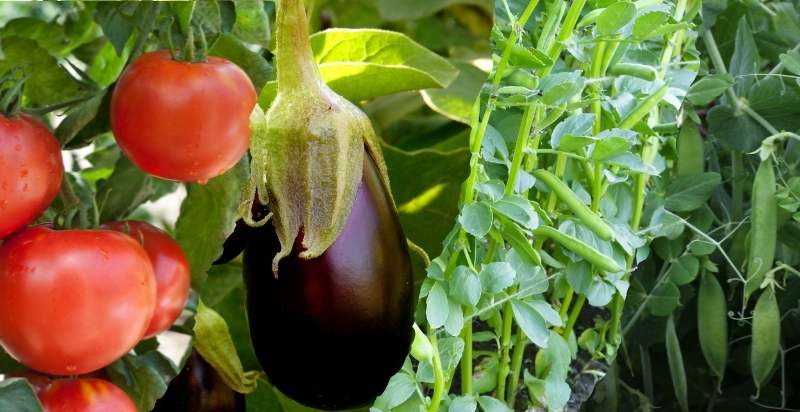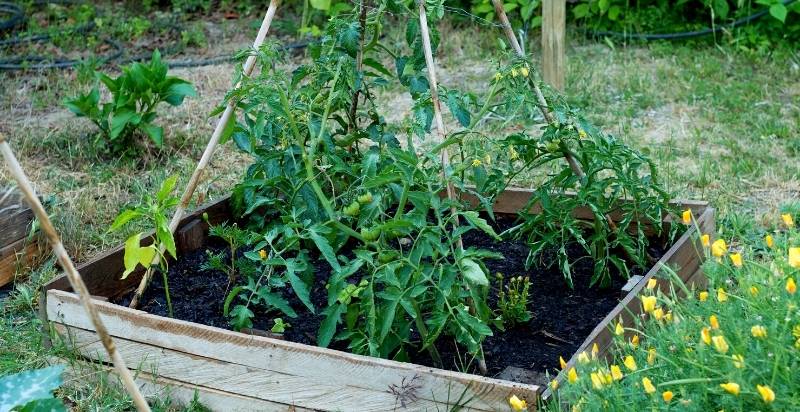A potager is a French term for an ornamental vegetable or kitchen garden. The historical design precedent is from the Gardens of the French Renaissance and early-17th-century formal baroque gardens. Many of the items grown in a potager are suitable for ornamental plantings and consumption.
The potager was developed in response to two trends in late medieval gardening:
- The use of herbs for their medicinal value; and
- A growing interest in horticulture as an aesthetic pursuit.
The word “potager” first appears in English in 1693, in John Evelyn’s Acetaria: A Discourse of Sallets.
A kitchen garden, which is sometimes called a potager, is a garden where fruits and vegetables are grown for the household to use. Kitchen gardens are usually located near the house, making them convenient.
What Are The Benefits Of A Potager Garden?
There are many benefits to having a potager garden. One benefit is that it can save money on groceries. Fresh fruits and vegetables from the garden are often cheaper than those from the store.
Another benefit is that homegrown produce is usually fresher and tastier than store-bought produce.
Additionally, growing your food can provide you with exercise and fresh air. Finally, having a potager garden can help you connect with nature and learn about plant life cycles.
Potager gardens are usually small and contained, making them easy to care for and ideal for people with limited space. They can be designed in several ways, but they are often planted in a grid pattern with raised beds, and this allows for easy accessibility and prevents the need for bending over when tending to the plants.
How Do You Design A Potager Garden?
Several aspects need to be considered when designing your potager garden, such as.
First, think about how much time you realistically have to devote to maintaining it. If you only have a few hours a week to spare, consider a miniature garden or one with fewer vegetables.
Second, decide what kinds of vegetables you want to grow. Do you want a mix of salad greens and root crops? Herbs? Be sure to choose plants that will do well in your climate and soil type.
Third, consider how you will use your bounty. Do you plan on canning or freezing some of your harvests? Will you be giving away produce to friends and neighbors? Knowing how much and what kinds of products you plan on using will help you determine the size and layout of your garden.
Finally, remember to leave some room for flowers! A few blooming plants will add beauty to your potager and attract pollinators that will help your vegetables grow.
When you have a plan, sketch it on paper or use a gardening software program to help you finalize your design. Once you’ve planned your potager garden, it’s time to get planting!
How Do You Design A Potager Garden To Fit Your Needs And Lifestyle?
A potager garden is typically divided into quadrants or sections, each with its purpose. For example, one section might be devoted to herbs, while another might be devoted to vegetables.
If you are limited on space, it is still possible to have a beautiful and productive potager garden. The key is to design it to maximize the use of space. Here are a few tips:
- Choose Compact Plants: Compact varieties of vegetables and herbs can be just as productive as their larger counterparts. Plus, they take up less space in the garden.
- Grow Vertically: Take advantage of vertical space by growing plants up trellises or lattices, giving you more room to grow other plants beneath them.
- Use Containers: If you don’t have much space for a traditional garden, consider using containers instead. Just make sure to pick ones that are big enough to fit the roots of your plants.
- Interplant: To get the most out of your garden, try interplanting – when you plant different crops in the same area. For example, you could plant lettuce between rows of tomatoes. This not only saves space but also has the potential to reduce pests and increase agricultural yields.
By following these tips, you can design a potager garden that is both beautiful and functional. You can make the most out of even the smallest space with a little planning.

What Plants Should You Include In Potager Garden, and How Do You Care For Them?
A potager is a type of kitchen garden designed to be functional and ornamental. It typically includes a variety of vegetables, herbs, and flowers, all grown together in raised beds or containers.
While the plants in a potager garden can vary depending on your preferences, a few common varieties are often included. These include lettuce, tomatoes, peppers, eggplants, beans, and peas. Most potager gardens also have at least one fruit tree or bush, such as strawberries, raspberries, or apples.
In addition to being productive, potager gardens can also be quite beautiful. The proximity of the plants results in a colorful and fragrant landscape that is sure to please the senses.
When planning your potager garden, it is important to consider the needs of each plant. Some vegetables, for example, require full sun, while others do better in partial shade. Herbs are often quite versatile and can tolerate various growing conditions.
Once you have selected the plants for your garden, the next step is to prepare the soil. This can be done by adding organic matter such as compost or manure. It is also important to ensure the soil is well-drained, so the plants stay waterlogged.
After the soil has been prepared, it is time to start planting! When doing so, give each plant enough space to spread out and grow. After the plants are established, you must give them frequent waterings and periodic fertilization.
As your plants mature, you can start harvesting their fruits and vegetables. With a little care and attention, your potager garden will provide fresh, delicious food for many years!

What Are Some Tips For Keeping Your Potager Garden Looking Beautiful All Year Round?”
With any garden, a potager garden needs to be properly cared for to remain in good condition. This section will give you some care and maintenance tips for your potager garden to keep it looking its best.
1. Watering
One of the most important aspects of potager garden care is watering. Your plants will need to be watered regularly, especially during hot weather. You should check the soil daily and water it whenever it feels dry to the touch.
If you have an irrigation system in place, ensure that it works properly and that the water is getting to all your plants. If you do not have an irrigation system, you must water your garden by hand using a hose or watering can.
2. Weed Control
Weeds are one of the biggest enemies of any garden, and potager gardens are no exception. They can compete with your plants for nutrients and water and make your garden look untidy.
You will need regular weeding to keep your potager garden looking its best. Use a hoe or trowel to remove any weeds you see, and be sure to get rid of them completely, so they do not regrow.
3. Fertilizing
Your potager garden must also be fertilized regularly to stay healthy and productive. Use an organic fertilizer such as compost or manure, and apply it around the base of your plants according to the package directions.
4. Pest Control
Pests can be a big problem in any garden, and potager gardens are no exception. Several pests, including aphids, slugs, and caterpillars, can attack your plants.
You must take action immediately if you notice any pests in your garden. There are several different ways to control pests, including using pesticides or traps.
5. Harvesting
Gathering fresh produce is one of the best benefits of having a potager garden. Once they are ready to consume, most vegetables and herbs can be harvested. Harvesting tips for the best results from your potager garden
The following tips will help you maximize your harvest while minimizing waste:
- Time your harvesting to coincide with peak ripeness. This will vary depending on the crop type, but vegetables are generally at their best when fully mature but firm. For example, tomatoes should be harvested when deep red and slightly soft to the touch.
- Use sharp knives or pruners to avoid damaging plants and losing valuable crops.
- Take care to avoid over-harvesting from any one plant. Leaving some fruits and vegetables on the plant will ensure that it continues to produce throughout the season.
- Be sure to clean up any fallen fruits or vegetables from the ground to prevent rot and disease.
- Store harvested crops in a cool, dry place if you are not planning to consume them immediately, which will help extend their shelf life.
These are just a few of the care and maintenance tips you need to know to keep your potager garden looking its best. Be sure to check your plants regularly so that you can harvest them at the peak of ripeness. Once you have harvested your produce, you can then enjoy it fresh or preserve it for later use.
How Can You Use Your Potager Garden To Improve Your Home’s Curb Appeal?
Your potager garden can play a big role in boosting your home’s curb appeal. Here are four ways to do it:
1. Choose Plants That Will Add Color and Interest
When selecting plants for your potager garden, choose those that add color and interest to the space. Brightly colored flowers and foliage will make your potager garden pop and help it stand out from the rest of your landscaping.
Consider planting annual flowers such as impatiens, petunias, and marigolds to add a splash of color. Or, plant perennial flowers like daylilies, coneflowers, and black-eyed Susans that will come back year after year. Foliage plants such as hostas, ferns, and Wentworth can add interest and texture to your potager garden.
2. Incorporate Ornamental Elements
In addition to plants, you can also incorporate other ornamental elements into your potager garden to make it more visually appealing. Statues, bird baths, trellises, and other garden accents can add interest and personality to your space. Choose items that reflect your style and taste.
3. Use Containers to Add Pizzazz
Consider using containers if you’re limited space or want to add height to your garden. Flowerpots, hanging baskets, and window boxes are all great options for incorporating plants into your potager garden. Be sure to choose various sizes and colors of containers to add visual interest.
4. Fence It In
If you need help with how to integrate your potager garden into the rest of your landscaping, consider fencing it in. This will define the space and make it more distinct from the rest of your yard. A picket fence or a low stone wall are good options for enclosing a potager garden.
5. Keep It Well-Maintained
A potager garden needs constant upkeep to stay in top condition, just like any other garden, such as Watering the plants frequently, especially in the summer when it’s hot. As soon as weeds appear, pull them out and fertilize your plants as needed.
A potager garden is a great way to add beauty and functionality to your home. By following these tips, you can create a potager garden that will make your house stand out from the rest and increase curb appeal.

Conclusion
A potager garden is a great addition to any home. Not only do they provide fresh fruits and vegetables, but they also enhance curb appeal. Follow these tips if you’re thinking about adding a potager garden to your home.
- Everything You Wanted to Know About Red Tamarillos - June 2, 2025
- A Guide to Tulips: Everything You Need to Know & More… - June 2, 2025
- Guanabana: Description, Flavor, Benefits, And Uses - May 27, 2025

5 thoughts on “How to Design a Potager Garden ”